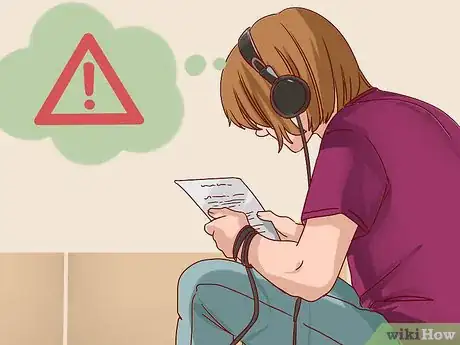This article was co-authored by Alexander Ruiz, M.Ed.. Alexander Ruiz is an Educational Consultant and the Educational Director of Link Educational Institute, a tutoring business based in Claremont, California that provides customizable educational plans, subject and test prep tutoring, and college application consulting. With over a decade and a half of experience in the education industry, Alexander coaches students to increase their self-awareness and emotional intelligence while achieving skills and the goal of achieving skills and higher education. He holds a BA in Psychology from Florida International University and an MA in Education from Georgia Southern University.
There are 11 references cited in this article, which can be found at the bottom of the page.
This article has been viewed 22,832 times.
The International English Language Testing System (IELTS) is a test that’s used to measure your English-language skills if you want to work or study in an English-speaking country. There are 4 parts of the exam: Listening, Reading, Writing, and Speaking. To improve your Listening score, it’s important to get familiar with the test format. You should also prep with courses and practice exams. Finally, listen to podcasts and audiobooks about topics you love to take your listening skills to the next level.
Steps
Reviewing the Test Format
-
1Expect 4 sections with 10 questions each. You’ll hear 4 recordings, and you’ll need to answer the questions in your test booklet as you listen to them. The first 2 sections focus on everyday situations. Section 1 will be a conversation between 2 speakers about something like travel arrangements, and section 2 will be a monologue about another everyday topic. Sections 3 (another dialogue) and 4 (a monologue) will cover academic or training-related topics, such as workplace policies or a lecture about a novel.[1]
- It will take about 30 minutes for you to listen to all 4 sections.
- You will only be allowed to listen to the recordings once.
-
2Be prepared for different accents. The recordings will contain several different English accents. You’ll hear speakers from the UK, United States, Australia, New Zealand, and Canada.[2] The accents will be “neutral,” which generally means the kind of accent you can expect to hear in urban centers like London or New York.[3]
- You don’t need to worry about Scottish, Irish, or rural Australian or New Zealand accents. You also won’t need to prepare for speakers with thick American accents from someplace like Texas or Boston.
Advertisement -
3Get ready for several different types of questions. There are 40 questions, each worth 1 point. There are 5 varieties of questions that will be mixed throughout the exam. These question types are:[4]
- Multiple choice. For these questions, you’ll either need to pick an answer from 3 possibilities, or choose from 3 possibilities to complete a sentence. Sometimes, the question will ask you to choose more than 1 answer.
- Matching. These questions require you to match items from 2 side-by-side sets of lists.
- Plan, Map, or Diagram Labeling. You’ll need to fill in labels on a plan (of a building, for example), a map (of a town or city), or a diagram (i.e. for a piece of equipment). You’ll generally be given a list of possible labels to choose from.
- Form, Note, Table, or Flow-Chart Completion. For these questions, you’ll need to fill in the blanks in these various types of documents or diagrams. You may be given possible answers, or you’ll need to pick them out from the recording.
- Sentence Completion. You’ll read a few sentences summarizing information either from all of the Listening exam, or from 1 section. You’ll need to fill in blanks in each sentence based on what you heard in the recording.
-
4Pay careful attention to the instructions on each question. Read every word in each question. You don’t want to miss a multiple choice question that tells you to choose more than 1 answer. Additionally, for fill-in-the-blanks, you will often face a word limit. If you use more words than the word limit specifies, your answer will be marked incorrect.[5]
- For example, a Sentence Completion question might say “No more than 2 words and/or a number.”
- Hyphenated words (like mother-in-law) count as 1 word.
-
5Answer questions on the booklet then transfer them to an answer sheet. After about 30 minutes of recording time, you’ll be given 10 minutes to transfer your answers to a formal answer sheet. During the recording itself, you can use the question booklet to mark down your answers. When you transfer them, be very careful with spelling and grammar. Misspelled words or ungrammatical sentences will earn you an incorrect answer.[6]
-
6Try to answer every question. You are not penalized extra for an incorrect (versus a blank) answer. It’s best to attempt a guess and potentially have a correct answer than to not try at all.
-
7Take approximately 40 minutes to complete the exam. Between 30 minutes of recording time and 10 minutes of transfer time, you’ll be done in under an hour.[7]
Prepping with Courses and Practice Tests
-
1Go online to look for sample test questions and exams. You can find sample questions by visiting the official IELTS website: https://www.ielts.org/en-us/about-the-test/sample-test-questions. There are also lots of downloadable practice exams online. These exams and questions will familiarize you with the format of the exam. Getting comfortable with the types of recordings and questions you’ll face is key to improving your score.[8]
- The British Council, for example, has a practice exam available here: https://takeielts.britishcouncil.org/prepare-test/free-sample-tests/listening-sample-test-1/listening-section-1.
-
2Enroll in an in-person prep course. If you feel more comfortable studying in a structured, classroom environment, a test preparation course may be right for you. Be aware that if you choose in-person instruction, these classes can get pricey. You may need to spend some time saving up or budgeting if you feel you need a class to pass the IELTS exam.[9]
- For example, an official IELTS test preparation course administered by an English Language Center (ELC) in Boston or Los Angeles costs $445 USD per week, and it last 4-7 weeks. If you choose a less accelerated program (24-47 weeks, for example), instruction costs $385 USD per week.[10]
-
3Choose an online prep course if you’re on a budget. Online courses will generally be less expensive (and may sometimes be available for free!) than classroom instruction. However, you’ll receive less one-on-one interaction with your instructor(s) and fellow classmates. Still, this is a good option if you feel like a course will help you develop a structured study plan.
- The British Council provides access to a free online preparation seminar. Go online to find enrollment dates for this class.
- You’ll be able to find 8-week online prep courses for about $100 USD.[11]
-
4Purchase official IELTS audio CDs and practice tests. Especially if you’re not enrolled in a class, it’s a good idea to get a test prep booklet. The CD contains samples of the Listening exam. The booklet also provides examples of examiner comments on responses. Reading these comments will help you understand what the test-givers are looking for in a correct answer.[12]
-
5Simulate the test environment during practice tests. Choose a quiet spot where you know you won’t be interrupted for at least an hour. Time yourself so that you don’t go over the 30 minute mark for the recordings. Leave just 10 minutes at the end of your practice exam to transfer your answers to the “official” answer sheet.[13]
Listening to Podcasts and Audiobooks
-
1Pick several topics you’re interested in. It’ll be much easier to listen to English-language materials if they’re about things you like! Make a list of 5 things you’re interested in learning about. You can then look up podcasts and audiobooks about those 5 subjects.[14]
-
2Watch TV series when you start studying. TV series are a good spot for you to start out, as you’ll be able to read lips and facial expressions to help you understand what’s going on. Once you’ve gotten better at listening to English being spoken, however, it’s a good idea to move on from TV or movies. Listening without seeing is tougher, and you don’t want the visuals to become a crutch.[15]
-
3Find free podcasts to listen to on your commutes or during free time. The best part about podcasts is that you can find thousands of them for free! Download them onto your phone or tablet so you can listen to them while you’re driving, on the train, or even waiting in line at the grocery store.
- If you’re struggling to find a podcast, look up lists of popular English-language podcasts about things like politics or entertainment. You can also ask friends and family for recommendations.
-
4Purchase audiobooks for a long-term study tool. Just like podcasts, you can listen to audiobooks when you’re on the move or doing laundry at home. Audiobooks may be more useful than podcasts for exposing you to new vocabulary. They’ll also help you learn English grammar rules. However, it may take you awhile to finish 1 audiobook, so be sure to choose one that excites you![16]
- Go online to find lists of popular audiobooks. If you’d like, you can also listen to English-language “classics” like Harper Lee’s To Kill a Mockingbird, Jane Austen’s Pride and Prejudice, or Toni Morrison’s Beloved.
-
5Listen to English music for a challenge. Because the music itself may cover up the lyrics, it’ll be tough to understand what’s going in songs when you first start studying. However, this is a good way to make listening harder for yourself! Go online to find song lyrics so you can double check your comprehension.[17]
- Sing along to really commit the words to your memory!
Expert Q&A
Did you know you can get expert answers for this article?
Unlock expert answers by supporting wikiHow
-
QuestionHow can I get better at reading English?
 Alexander Ruiz, M.Ed.Alexander Ruiz is an Educational Consultant and the Educational Director of Link Educational Institute, a tutoring business based in Claremont, California that provides customizable educational plans, subject and test prep tutoring, and college application consulting. With over a decade and a half of experience in the education industry, Alexander coaches students to increase their self-awareness and emotional intelligence while achieving skills and the goal of achieving skills and higher education. He holds a BA in Psychology from Florida International University and an MA in Education from Georgia Southern University.
Alexander Ruiz, M.Ed.Alexander Ruiz is an Educational Consultant and the Educational Director of Link Educational Institute, a tutoring business based in Claremont, California that provides customizable educational plans, subject and test prep tutoring, and college application consulting. With over a decade and a half of experience in the education industry, Alexander coaches students to increase their self-awareness and emotional intelligence while achieving skills and the goal of achieving skills and higher education. He holds a BA in Psychology from Florida International University and an MA in Education from Georgia Southern University.
Educational Consultant The best thing you can do is practice! Tutors can be helpful when it comes to working on your English skills. Another thing you can do is just immerse yourself in the language. Practice reading English texts in your off time. If that's really hard for you, try audiobooks! Even listening to English will make it easier for you to learn new words and grammar rules.
The best thing you can do is practice! Tutors can be helpful when it comes to working on your English skills. Another thing you can do is just immerse yourself in the language. Practice reading English texts in your off time. If that's really hard for you, try audiobooks! Even listening to English will make it easier for you to learn new words and grammar rules.
References
- ↑ https://www.ielts.org/en-us/about-the-test/test-format-in-detail
- ↑ https://www.ielts.org/en-us/about-the-test/test-format-in-detail
- ↑ https://magoosh.com/ielts/accents-expect-ielts-listening/
- ↑ https://www.ielts.org/en-us/about-the-test/test-format-in-detail
- ↑ https://www.ielts.org/en-us/about-the-test/test-format-in-detail
- ↑ https://www.ielts.org/en-us/about-the-test/test-format-in-detail
- ↑ https://www.ielts.org/en-us/about-the-test/test-format-in-detail
- ↑ https://www.ielts.org/en-us/about-the-test/sample-test-questions
- ↑ https://www.ielts.org/en-us/book-a-test/prepare-for-your-ielts-test
- ↑ https://www.elc.edu/english-courses/english-test-preparation-courses/ielts-test-preparation-course/
- ↑ https://www.edx.org/course/ielts-academic-test-preparation-uqx-ieltsx-1#!
- ↑ https://www.ielts.org/en-us/book-a-test/prepare-for-your-ielts-test
- ↑ https://ieltscanadatest.com/2017/02/eight-ways-to-improve-your-ielts-listening-score/
- ↑ https://ieltscanadatest.com/2017/02/eight-ways-to-improve-your-ielts-listening-score/
- ↑ https://magoosh.com/ielts/practice-ielts-movies-tv/
- ↑ Alexander Ruiz, M.Ed.. Educational Consultant. Expert Interview. 18 June 2020.
- ↑ http://www.telegraph.co.uk/news/science/science-news/10188533/Singing-can-help-when-learning-a-foreign-language.html
- ↑ https://www.ielts.org/en-us/what-is-ielts/ielts-introduction




































































